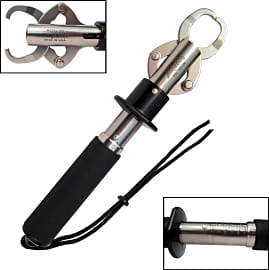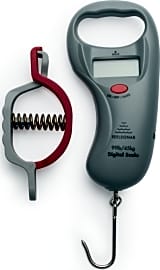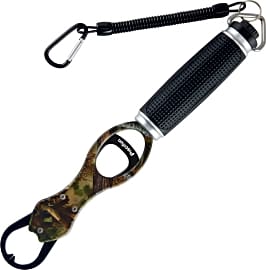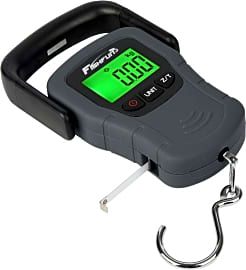The 10 Best Fishing Scales

This wiki has been updated 38 times since it was first published in January of 2016. With one of these scales, you'll be able to prove you're not just telling a fish story about your latest monster catch. We've included both battery-operated digital versions that can help cull your haul during tournaments as well as analog devices to satisfy the old-school adherents out there. Most can handily double as a luggage scale to help you avoid excess baggage fees, too. When users buy our independently chosen editorial choices, we may earn commissions to help fund the Wiki.
Editor's Notes
June 25, 2021:
The only change we made was upgrading to the 50lb version of the Rapala Touch Screen Tourney. The Rapala High Contrast is a touch nicer, but it's meant for hanging from a bracket or pole and not ideal for handheld use. For budget-friendly options, consider the Reel Sonar Digital or the analog Weston Scale Spring & Hook. Meanwhile, the Eastaboga Tackle Boga Grip might really be the most high-end, but its high cost makes it a non-starter for many fishermen.
March 13, 2020:
To find the best fish scale we considered models that fit a variety of fishing styles and objectives. We evaluated the top digital choices for anglers who need the detailed measurements to the decimal point, and some, including the Rapala Touch Screen Tourney and the Kast King Mad Bite provide a memory function for keeping track of multiple catches.
The Rapala Touch Screen Tourney takes the top spot for its versatile ability to track the weights of up to eight different fish for the day, and additionally provides numbered clips so that you know which one is which. It's great for anyone who needs to use a simple to navigate touch screen.
We've also included the best options for those who simply want to weigh and display their catches. Users don't need to worry about batteries and buttons. While they don't provide as much detail, our choices are still designed for accuracy to the half or quarter pound increment.
The Eastaboga Tackle Boga Grip is a favorite amongst fishing enthusiasts, because of its robust construction and simple accuracy that doesn't require batteries. It's accurate enough to be used in competitions. There's a robust lip clamp on this style of scale that is ideal for catch and release fishing, as it is gentler to the fish than a sharp hook.
Spring Into Accuracy
By simply hanging the fish on the scale you get a pretty accurate reading.
When you're out on the water and you snag a particularly enviable fish, you might take a quick picture of yourself holding it. If you have a signal you might even post that picture to social media. The problem there, if you're going to brag with specificity, would be giving the details of the catch. A simple ruler would be enough to share the length, but in most scenarios weight is just as important, if not a more important bragging point.
To that end, you want to employ a simple fishing scale. Some of these will give you an incredibly accurate reading in the field, while others are more for general classification and safeguarding against fraud from a tender who might buy your catch. A fishing scale works in one of two ways, depending on its mechanism for reading weight.
One type operates by a spring, and the other by a piezoelectric transducer. The spring probably sounds more familiar to you. Essentially, spring loaded fishing scales connect their central spring to a hook or a clamp that holds the fish. As gravity pulls the fish down toward the earth, that force stretches the spring. At the other end of the spring is a small indicator that moves along lines marked with certain weights and calibrated in the scale's factory before release. By simply hanging the fish on the scale you get a pretty accurate reading.
While spring-loaded fishing scales are the least expensive and most ubiquitous type, there are also digital versions that operate by that fancy transducer mentioned above. Piezoelectricity is a charge created by pressure placed on a crystal. Certain crystals are particularly sensitive to pressure, and manufacturers calibrate their scales to the amount of charge produced by the range of measurable stresses.
When you hang a fish on a digital fishing scale, the pressure its interaction with gravity places on the small crystal inside the scale creates a readable charge that the transducer translates into a weight reading. These scales tend to be far more accurate than their spring-loaded counterparts, but they also tend to be more expensive.
A Tidy Boat Is A Fisherman's Best Friend
Even on an industrial stage, fishermen are bound to squabble over exact weights with their tenders, the people responsible for purchasing their catch and selling it to canneries and other distributors. If you catch fish for sale, even on the smallest stages, you want to ensure that you aren't being taken for a ride. If it's just a hobby, however, and exact weights aren't entirely necessary to your experience, then you might not need the most accurate scales available.
If you catch fish that regularly come close to the maximum weight of a given scale, you should look for a scale that can handle a little more fish.
Knowing your needs when it comes to your fishing scale purchase will help you narrow down our list to a few options, and from there you can make your choice based on budget or hook style.
We've already gone over the differences between digital and spring-loaded scales above, and the big split between those two types is accuracy and price. Another important thing to consider with your digital scales is that they require batteries to operate, and that you can't get those batteries wet. If you have a boat with limited space or you're a messier fisherman, you might do better with a spring-loaded scale, so you won't need to pack batteries or worry about your scale encountering the elements.
If you keep your vessel a little tidier, and you have both the space and the budget to accommodate a digital scale and its batteries, you'd do well to go down that path. Keep an eye out for each scale's maximum weight reading, as well. If you catch fish that regularly come close to the maximum weight of a given scale, you should look for a scale that can handle a little more fish. That way, when you catch something bigger than you've ever caught before, you can still get an accurate reading.
Would You Eat A 40,000-Year-Old Fish?
Before the advent of the scale in ancient Egypt around 2,400 BCE, there was no banking. At the time, there wasn't any surefire way to establish an equivalence of goods beyond the haggling and bartering of merchants. The scale changed all of that, and, in a loose way, can be blamed for all the problems of our modern economy. We didn't come here to get down on the Egyptians for ruining everything, though. Somebody would have come up with it eventually.
Those early scales were balance scales, meaning that they balanced a set of goods against a counterweight placed at an equal distance from a fulcrum.
Those early scales were balance scales, meaning that they balanced a set of goods against a counterweight placed at an equal distance from a fulcrum. Long before anybody though to do any of this, however, human beings had long gone fishing.
Radio carbon dating of skeletal remains found in the Tianyuan Cave near Beijing, China ages them at about 40,000 years. Isotopic analysis of those same bones shows that this early human skeleton belonged to a man whose diet consisted predominantly of freshwater fish. Evidence of hooks, barbed spears, and other tools–both physical and depicted in cave paintings–imply the methods used by early man.
The one thing he didn't have was a good scale. Weight wouldn't become the marker of a good catch until the Egyptians and their bankers got a hold of the fish in question and plopped it down on their balances. Once spring-loaded scales for weighing people came into being in the 1800s, it was only a matter of time before smaller sizes of the same design would become popular for weighing all kinds of things, including fish.















